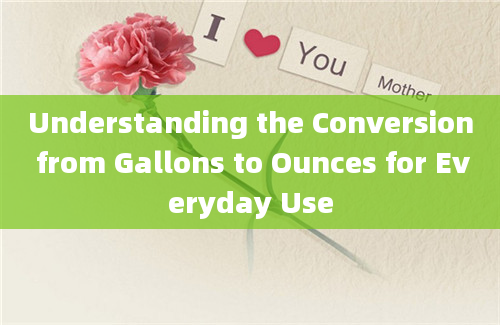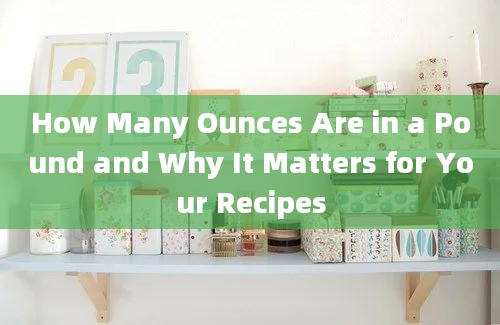Understanding the Conversion from Gallons to Ounces for Everyday Use

Introduction
The conversion from gallons to ounces is a common task in everyday life, especially in the United States where the imperial system is predominantly used. Whether you are cooking, gardening, or managing household chores, understanding this conversion can be incredibly useful. This article delves into the details of converting gallons to ounces, providing a comprehensive guide with authoritative sources.
Basic Conversion Factors
1. US Liquid Gallon to Ounces:
1 US liquid gallon = 128 US fluid ounces
Source: [National Institute of Standards and Technology (NIST)](https://www.nist.gov/pml/weightsandmeasures/metricsi/siunitsvolume)
2. UK (Imperial) Gallon to Ounces:
1 UK gallon = 160 UK fluid ounces
Source: [UK Government Weights and Measures](https://www.gov.uk/guidance/weightsandmeasures)
Why is This Conversion Important?
Understanding the conversion from gallons to ounces is crucial for several reasons:
1. Cooking and Baking: Recipes often require precise measurements, and knowing how to convert between these units can prevent errors.
2. Gardening: When mixing fertilizers or pesticides, accurate measurements are essential for effectiveness and safety.
3. Household Management: For tasks like filling water containers or measuring cleaning solutions, this conversion is handy.
Historical Context
The gallon has a rich history, with its origins dating back to the medieval times. The term "gallon" comes from the Latin word "galleta," meaning a pail or a liquid measure. Over the centuries, the definition and size of a gallon have varied, leading to the establishment of different standards in different regions.
US Gallon: Established in the 19th century, the US liquid gallon is based on the wine gallon used in England prior to 1824.
UK Gallon: Also known as the imperial gallon, it was defined in 1824 and is larger than the US gallon.
Practical Applications
1. Cooking: For instance, if a recipe calls for 2 gallons of water, you would need 256 ounces (2 x 128).
2. Gardening: If a fertilizer mix requires 1/2 gallon of water, you would use 64 ounces (0.5 x 128).
3. Household: Filling a 5gallon water jug means you are dealing with 640 ounces (5 x 128).
Tools for Conversion
Several tools can aid in this conversion:
1. Online Converters: Websites like [ConvertUnits.com](https://www.convertunits.com/from/gallon/to/fluid+ounce) offer instant conversion.
2. Mobile Apps: Apps like "Unit Converter" can be downloaded for quick calculations.
3. Manual Calculation: Simple multiplication using the conversion factors mentioned above.
Conclusion
Understanding the conversion from gallons to ounces is a practical skill that enhances efficiency in various daily activities. By grasping the basic conversion factors and utilizing available tools, anyone can master this essential aspect of measurement.
Frequently Asked Questions (FAQs)
Q1: How many ounces are in a US liquid gallon?
A1: There are 128 US fluid ounces in a US liquid gallon. (Source: [NIST](https://www.nist.gov/pml/weightsandmeasures/metricsi/siunitsvolume))
Q2: How many ounces are in a UK (Imperial) gallon?
A2: There are 160 UK fluid ounces in a UK gallon. (Source: [UK Government](https://www.gov.uk/guidance/weightsandmeasures))
Q3: Why is the UK gallon larger than the US gallon?
A3: The UK gallon, or imperial gallon, was defined in 1824 and is based on the volume of 10 pounds of water at 62掳F, making it larger than the US gallon, which is based on the wine gallon used in England prior to 1824.
Q4: How do I convert 3 US gallons to ounces?
A4: To convert 3 US gallons to ounces, multiply 3 by 128, which equals 384 US fluid ounces.
Q5: Can I use online converters for this conversion?
A5: Yes, online converters like [ConvertUnits.com](https://www.convertunits.com/from/gallon/to/fluid+ounce) are reliable and convenient for converting gallons to ounces.
Q6: Is the conversion factor the same for dry gallons?
A6: No, the conversion factor for dry gallons is different. 1 US dry gallon equals 148.946 US fluid ounces. (Source: [NIST](https://www.nist.gov/pml/weightsandmeasures/metricsi/siunitsvolume))
Q7: How accurate are mobile apps for unit conversion?
A7: Mobile apps like "Unit Converter" are generally very accurate and userfriendly, providing quick and reliable conversions.
Q8: Why is it important to know this conversion for cooking?
A8: Precise measurements are crucial in cooking and baking to ensure the desired outcome and consistency of recipes.
Q9: How can I manually calculate gallons to ounces?
A9: Simply multiply the number of gallons by the conversion factor (128 for US gallons and 160 for UK gallons).
Q10: Are there any historical reasons for the difference in gallon sizes?
A10: Yes, the differences stem from historical variations in the definition and standardization of volume measurements in different regions, leading to distinct US and UK standards.










